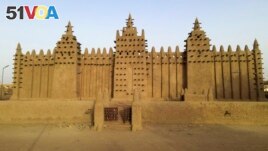24 May 2024
Kola Bah used to earn money as a guide in Mali's historic city of Djenné, once a center of Islamic learning.
The city is known for its large Grand Mosque of Djenné. The religious center has been on the UNESCO World Heritage in Danger list since 2016.
The world's largest mud-brick building used to draw tens of thousands of visitors to central Mali every year. Now, the structure is threatened by conflict between rebels, government forces and other groups.

The world's largest mud-brick building, the Great Mosque of Djenne, Mali, awaits its annual replastering, Friday, May 10, 2024. (AP Photo/Moustapha Diallo, File)
Bah says the money he used to earn was enough to support his family, which now includes nine children, and to pay for a small group of cattle.
But now, few visitors come to the city. Bah has been largely out of work. When he needs money, he sells some of his cattle.
Grand Mosque
Djenné is one of the oldest towns in sub-Saharan Africa. It has served as a market center and an important link in the trans-Saharan gold trade. Almost 2,000 of its traditional houses still survive in the old town.
The Grand Mosque, built in 1907 on the area of an older mosque dating back to the 13th century, is worked on every year by local people. The work is a ritual that brings together the entire city. The large, earth-colored structure requires a new layer of mud before the rainy season starts.
Women are responsible for carrying water from the nearby river to mix with clay and rice hulls. This mixture is the mud used to cover the wall of the structure. Adding a new layer of mud is a job for men. The joyful ritual is a source of pride for a city that has fallen on hard times, uniting people of all ages.
Bamouyi Trao Traoré is one of Djenné's lead builders. He said they worked as a team from the very start. This year's wall covering took place earlier in the month.
"Each one of us goes to a certain spot to supervise," he said. "This is how we do it until the whole thing is done. We organize ourselves, we supervise the younger ones."
Conflict and the future
Mali's conflict broke out following a coup in 2012. Militant groups took control of important northern cities. A French-led military operation pushed them out of the city centers the following year, but the success was short-lived.
The militants regrouped and launched attacks on the Malian military, as well as the United Nations, French and other forces in the country. The militants publicly stated their connection to al-Qaida and the Islamic State group.
Sidi Keita is the director of Mali's national tourism agency in the capital of Bamako. Keita said the drop in tourism was sharp following the violence.
"It was really a popular destination," he said, describing tens of thousands of visitors a year and adding that today, tourists are rare in Mali.
Despite being one of Africa's top gold producers, Mali ranks among the least developed nations in the world, with almost half of its 22 million people living below the national poverty line. Without tourism, few means are left for Malians to make a living.
Anger over what many Malians call "the crisis" is rising. The country also saw two more coups since 2020, during a wave of political instability in West and Central Africa.
Moussa Moriba Diakité is head of Djenne's cultural office, which works to save the city's heritage. Diakité said there are other difficulties beyond security — including illegal digs and waste disposal in the city.
He said the office is trying to send a message that security is not as bad as it seems. The office also hopes to get more young people involved in the mud-covering ritual, to help the new generation recognize its importance.
"It's not easy to get people to understand the benefits of preserving cultural heritage right away," he said.
I'm John Russell.
Moustapha Diallo reported on this story for the Associated Press. John Russell adapted it for VOA Learning English.
___________________________________________
Words in This Story
cattle -- n. cows that are kept for meat or milk
ritual – n. a series of acts done in the same way each time
layer -- n. an amount of something that is spread over an area
hull -- n. the outer covering of a fruit or grain
tourism – n. the activity of traveling for fun
benefit – n. a good or helpful effect